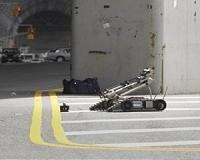 |
Tokyo (AFP) May 3, 2011 Japan may be at the forefront of robotics and its children raised on cartoons of robot heroes and villains, but the country has so far had to rely on US-made machines for help tackling its nuclear crisis. The massive March 11 earthquake and tsunami knocked out reactor cooling systems at the Fukushima nuclear power plant northeast of Tokyo, where workers are battling to prevent radiation leaks and a total meltdown. Although Japan is reliant on atomic power and leads the world in developing humanoid machines and industrial robots it has not developed any robots to tackle nuclear accidents. Plant operator Tokyo Electric Power Company (TEPCO) has sent in a pair of US-made crawler PackBot robots to examine areas where radiation from the rubble left by explosions is too high for humans to enter. Experts say the government has not provided enough funding to develop its own specialised disaster robots, which have no commercial market. "In the case of housekeeping robots, the market is there and so the companies can continue the development," said Hajime Asama, professor of engineering at Tokyo University and a member of a robot taskforce set up after the disaster. "In the case of the United States, the military invests a lot of money for this kind of robot. But in Japan it is prohibited to make military robots," he said. A mistaken belief that such a nuclear disaster would never happen in Japan is also to blame, he said. "That's why the Japanese government did not invest sufficient money to develop this kind of robot system. They invested initial money for developing the robot system but they didn't continue," said Asama. Fellow taskforce member Satoshi Tadokoro, professor of robotics at Tohoku University, who specialises in rescue robots, said more than one type of robot would be needed, given the various problems within the plant. For the moment, the taskforce is recommending the use of the compact Japanese-made Quince robot, which has two main caterpillar tracks and four smaller protruding ones which can be angled up or down to enable it to climb over debris and up stairs. TEPCO says it is considering using the robot but there is no clear timetable for putting it to work. It takes three days to train a worker to use it. "We have heard the robot is good at moving around in rubble-scattered places. If we introduce it, we'll utilise it for on-the-spot surveys" in reactor buildings, a TEPCO spokesman said. Tadokoro said Quince was well-suited for the task. "Within the nuclear plant if the second and third floors need to be checked, there may be debris and water and the surface might be slippery. I think Quince is most suitable in these circumstances," he said. "The most difficult thing is to have enough capacity to move around the nuclear plant. It is not very spacious, and filled with debris, so the robot has to go through this in order to check deeper inside the building." Japan had to come up with improvised response measures to the nuclear calamity, including using firetrucks and helicopters shielded with lead plates to dump water on the overheating reactors and spent fuel rod pools. "I believe that robots can't do everything and that some things need to be done by humans, and some need heavy machinery," said Tadokoro. "So by combining all things available, we need to bring the current situation to a cold shutdown." TEPCO has said it expects to bring all six reactors at the stricken plant into "cold shutdown", where reactor temperatures and pressure drop to safe levels, by some time between October and January. While humanoid robots such as Honda's ASIMO already exist, experts say it will be some time before such machines are capable of working like a human inside a nuclear plant. Honda on its website answers the question "could you make ASIMO take care of the nuclear accident?" It says ASIMO "has been developed to be useful for humans in the future, but at the moment unfortunately the technology has not reached the point where it can do what you have requested. We ask for your understanding." Kazuhito Yokoi, deputy director of Intelligent Systems Research Institute which developed the dancing HRP-4 humanoid robot, said: "This robot took about three years to develop, but compared to a human it's just taking baby steps. "For a robot to be able to work at Fukushima we still need further research and development." Asama said the operations centre was discussing which robots to use in the plant. "They don't care whether the robot is made in Japan or outside. They would just like to use the best, optimal robots for the missions," he said.
Share This Article With Planet Earth
Related Links All about the robots on Earth and beyond!
 Irobot Awarded 230 Million From US Navy
Irobot Awarded 230 Million From US NavyBedford MA (SPX) Apr 28, 2011 iRobot has announced that it received a $230 million indefinite-delivery/indefinite-quantity contract from the Naval Sea Systems Command (NAVSEA) on April 12, 2011. Under the contract's terms, NAVSEA can procure PackBot Man Transportable Robotic System (MTRS) robots, depot level repair parts, spare kits, depot repair services, parts supply, training, engineering enhancements, configuration ... read more |
|
| The content herein, unless otherwise known to be public domain, are Copyright 1995-2010 - SpaceDaily. AFP and UPI Wire Stories are copyright Agence France-Presse and United Press International. ESA Portal Reports are copyright European Space Agency. All NASA sourced material is public domain. Additional copyrights may apply in whole or part to other bona fide parties. Advertising does not imply endorsement,agreement or approval of any opinions, statements or information provided by SpaceDaily on any Web page published or hosted by SpaceDaily. Privacy Statement |